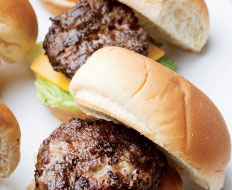For decades, the value proposition in quick-serve circles was pretty easy to capture in a catchphrase: More Is Better. Give those 18–34-year-old guys bigger burgers, burritos, sandwiches, and pizzas; super-size the drinks and sides; pile the toppings high; ladle on the extras, and you had a surefire formula for success.
Nowadays, the picture is a little more nuanced. Our national conversation about obesity has sunk deep into the collective consciousness. In our CCD Innovation surveys of Gen-Y consumers, even young men are displaying an unprecedented concern not just about the kinds of calories they consume, but also about the sheer number. This is a generation that’s tuned into the potential hazards of excessive sugar, sodium, and saturated fat consumption. That new reality makes this an excellent time for quick serves to find new and better ways to experiment with smaller portions, rendered creatively.
As I see it, small portions open up a world of intriguing possibilities for quick-serve concepts. For example, they permit the use of more expensive, premium-quality ingredients. While applewood-smoked bacon may be too pricey to drape over a regular-sized burger in multiple sheets, a bite’s worth tucked into a slider or a finger-sized chicken sandwich may not be cost-prohibitive. In a similar vein, while indulgent ingredients such as Burrata cheese, with its voluptuous mouthfeel and high fat content, might be a bit too much for consumers to take in substantial quantities, they could provide just enough richness to satisfy a craving for something decadent in small, bite-sized bits.
Small portions also allow menu developers to tinker with more provocative, piquant, and powerful flavors—and flavor combinations—that could overwhelm diners’ palates in larger quantities. A batch of mini pizza bites spiked with super-spicy sun-dried chiles can give guests just a pinch of the heat they love; an entire pie slathered in those same chiles might prove downright painful.
Marketing and packaging options also abound with smaller portions. Platter-type arrangements allow consumers to sample widely around a menu and can provide a platform for between-daypart snack offerings. In addition, there are cases where potential health benefits would extend beyond the actual downsizing itself. On a full-size submarine sandwich, for instance, a thin, lighter bun; flatbread; or crispy lavosh carrier might not cut the mustard. In a smaller format, though, a slim carrier might work just fine.
The best reason for quick-serve concepts to dive headlong into the small-portion game, though, is the fact that miniaturization and specialization have such widespread appeal. In my view, there are no fewer than nine quick-serve consumer subsegments that are, or could be, well served by an increased focus on small portions.
1) The Unstarved. These are diners with a hankering for something smaller than a meal, but more substantial than a handful of almonds or doughnut holes.
2) Calorie Counters. These health-conscious consumers on your block keep their eye on fat, sodium, sugar, and fiber content, and seek to eat less of what they love.
3) Wallet Watchers. Call them value conscious, call them pennywise; just don’t call on them to order a full-price meal if smaller, more affordable options are available.
4) Variety Mavens. Picking and choosing from among several items on the menu suits these folks fine, given as they are to building meals from several constituent parts.
5) Ethnic Adventurers. A subspecies of the Variety Maven, Ethnic Adventurers think of meals as exercises in cross-cultural discovery. A Thai chicken salad with a cup of Vietnamese coffee or an oolong tea is their idea of exotic travel on the cheap.
6) The Gen-Y Portion Patrol. They’ve been raised to avoid excess calories and understand that less is more when it comes to healthy eating.
7) The OK-in-Moderation Camp. This group favors measured restraint over outright self-denial. So while they’re unlikely to inhale a whole plate of fish and chips, an entire deep-dish pizza, or full-size batch of loaded potato skins, they will pick at smaller indulgences.
8) Build-It-Myselfers. These independent-minded consumers prefer to construct a meal from several pieces and parts of their own choosing, thereby providing them with the control.
9) Waste-Abhorrers. A relatively small niche, but one that can’t be ignored. These diners can’t bear to throw half a sandwich in the waste bin, yet they won’t want to reheat a half-eaten sandwich later on. The moral compunction can simply keep them from enjoying a normal-sized meal out.
With such a wide swath of consumers in play, it’s my strong recommendation that concepts that haven’t already explored the potential of downsized portions abandon their lingering reservations and start thinking big about getting small.











